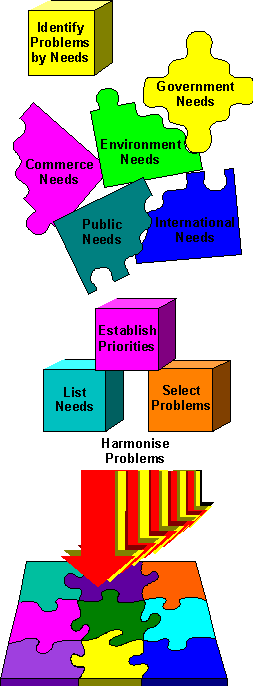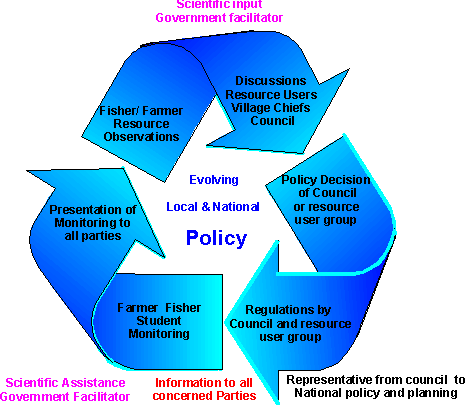Harmonizing National Sustainable Development Policy
- Planning for sustainable development relies on asking the right questions and having access to information.
- How conflicts arise during the policy making processes of the Pacific islands.
- The major types of policy conflicts and their social and economic costs.
- How participatory methods help harmonize policy conflicts.
Agenda 21 Chapter 8. Integrating Environment and Development in Decision Making.
8.5 Improving planning and management systems.
To support a more integrated approach to decision making the data systems and analytical methods used to support such decision making processes may need to be improved.
Countries will develop their own priorities in accordance with their national plans, policies and programs for the following activities.
a) Improving the use of data and information at all stages in planning and management making systematic and simultaneous use of social, economic, developmental, ecological and environmental data; analysis should stress interactions and synergism's; a broad range of analytical methods should be encouraged so as to provide various points of view.
b) Adopting comprehensive analytical procedures for prior and simultaneous assessment of the impacts of decisions, including impacts within and among the economic, social and environmental spheres; These procedures should extend beyond the project level to policies and programs; analysis should also include assessment of costs, benefits and risks.
The small, cash poor governments of the scattered Pacific islands are unable to identify or meet the information challenge in their quest to honor the stated sustainable development policies, and their commitments to Agenda 21. Workshops have brought together key people from governments, NGOs, and regional organizations to analyze problems in sustainable development from every angle. They have produced strong recommendations but when the participants go back to their offices, they are entrapped in the network of vested interests and concealment of information that they have just condemned in their workshops. And Pacific island ecosystems continue to degrade.
Real action towards achieving the goal of sustainable development has been sabotaged, in the Pacific islands, by deliberate and accidental restriction of information. Information control is threaded into the perplexing relationships between colonial imposed models of wealth & power, and traditional models of control of information and resources. Transparency in government activities may jeopardize important commercial processes - especially where land, water, mineral and living resources are at stake. Keeping secrets is a normal part of our civilization and the foundation of graft and corruption.
Just discovering the real condition of any natural resource is a difficult and complex scientific problem. Compounding this complexity with commercial and political interest creates a wealth of confusion. While secrecy is an understandable part of commercial enterprise, it is lethal when the information concerns the viability of the natural support systems of the environment.
Agenda 21 Chapter 8. Integrating Environment and Development in Decision Making.
"The overall objective is to improve or restructure the decision making process so that consideration of socio-economic and environmental issues is fully integrated and a broader range of public participation assured."
The Pacific island National Policies for resource use include the word sustainable, but they generate a number of serious conflicts. Harmonizing these conflicts requires, as Agenda 21 points out, a broad range of public participation.
The aim of sustainable development is to ensure the well-being of all people and of nature. This requires a holistic world view, blending social, economic and environmental concerns to provide a viable natural environment, capable of supporting life now and in the future. At the focus of this model - and the intent of Agenda 21 - is the well being of the community, the individuals who are its members, and the natural life systems of the planet that support human life.
Government plans in the Pacific Island Sub-Region reflect this understanding, but contain a multitude of conflicting policies when it comes to achieving it. Conflicting policies result in conflicts between people and organizations - and this leads to substantial economic loss as well as a poverty of achievement.
Conflict and poor planning inevitably results from a lack of information or misinformation. The quality and kinds of information available to planners and policy makers determines the efficiency of their efforts - and not incidentally the future of the country.
1) Sustainable development relies on asking the right questions and having access to information.
The future is always uncertain. Many people think planning is about making the right decisions. Planning is also the process of seeking the right questions - is this the right way to go? Should we take this opportunity or that one? Competent planners ask questions about a wide range of economic, social, environmental and political questions. Planning, and questioning, continues after choices are made and policies set.
Development could be defined as the ability to make more choices. Sustainable development is the quality of maintaining or expanding a diversity of choices. What shall we eat today? What tree will we use for wood? What shall we plant in our garden this season? What can we offer the tourists for an activity today? Consider the diversity of choices between asking those questions in Sydney versus on South Tarawa in Kiribati. Will the choices available to the people who live in Tarawa increase or decrease over the next five years as the population increases, the fish decrease, the land erodes, the ground water becomes more polluted and public health declines?
Information was often not available to enable competent decision making for resource use and management in the Pacific islands. There were numerous reasons why information was lacking or wrong, leading to poor decisions.
2) How conflicts arise during the policy making processes of the Pacific island sub-region.
Environmental and economic policy decisions were made on nine levels;
- Global
- Regional
- National
- Sectoral
- Local Government (Provincial or District)
- Community (Village or Sectoral community such as fishers or farmers).
- Corporate
- Family
- Personal
People who make policy decisions at each level have differences in viewpoint, needs, and information availability. The links between these policy decision factions depend on:
- Overriding political and moral policies
- Information flow between the levels
- Current environmental conditions (there can be considerable differences in how people behave during disasters or acute resource shortages).
Conflicts arise between and within each level. The worse the flow of information between the levels, the greater the conflicts and their attendant costs. Each of these levels had its own agenda and special interests. In the Pacific islands information is poorly shared between the various levels creating conflicts, distrust and clouded decisions.
The policy decision making process is driven from its ends; by the survival needs of individuals in the community and the career needs of professionals in the international aid community acting on a global commitment to foster sustainable development, alleviate poverty, and protect the environment. National governments, and their sectoral and provincial components, oscillate between these two poles, normally facing the flow of money while hoping their constituents and resources would at least look after themselves.
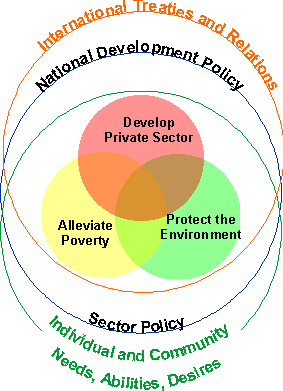
Potential conflicts between policies are at the intersection of multiple agendas.
International agreements and sustainability policy
Aid donors awoke the environmental conscience of the Pacific islands. They initiated and supported virtually all of the regional and national programs fostering environmental and then sustainable development issues.
Despite attempts to lever initiatives from National governments, availability of aid funds remain the focal point of the entire panorama of environmentalism from NGOs right through to Cabinet decisions.
When funds become available for any particular environmental issue, the whole apparatus from scientists in universities to national environmental units in 22 countries begin writing proposals to entrap some of the funds.
This wilts home grown initiatives from the grass roots up. Self reliance has become a liability. Projects that could be done with local volunteer efforts were ignored or stopped to highlight the dire need for substantial foreign funding. Projects of local concern withered before projects designed in places like Geneva and Nairobi where people were focussed on global issues such as climate change.
Because bilateral aid was tied to recycling aid funds back to the aid donor, outside experts from the donor country were called in to gather information, write reports, and manage projects even where local consultants were available and more knowledgeable of the issues. About 45% of bilateral aid is in the form of Technical Assistance. Short-term consultancies resulted in government policy statements written by foreign experts that often conflicted with social and political realities of the island country.
An exception to this practice was the development of National Environmental Management Strategies (NEMS) co-ordinated by the South Pacific Regional Environment Programme (SPREP). SPREP consultants, usually people from the region, helped initiate the establishment of multi-sectoral committees including NGO representation. The consultants then developed the proposed NEMS following meetings with this committee. The proposed NEMS were reviewed by the committee. This was a step in the right direction, but still quite different from a process where the committee itself reaches its own conclusions and priorities in deliberation with the community. The NEMS were "approved" by national governments throughout the region, primarily because the action plans recommended more funding opportunities. When the funding did not eventuate, the priorities and policies were quickly forgotten.
In Samoa, the priorities and recommendations of the NEMS were ignored by the same committee that was supposed to have formed them. But the committee did embark on its own process of environmental policy making. It took four years to achieve meaningful policy decisions on four key issues. Whereas the SPREP induced NEMS was "approved" by the Samoan Cabinet in a few months, the approval of the home grown priorities has taken much longer because it is being taken more seriously.
Although the international community of donors dictated environmental and development policy for the Pacific island countries, this policy was both necessary and desirable. Investigations by the World Bank, the Asian Development Bank, and various branches of the United Nations resulted in sound policy recommendations for a broad range of government issues. Aid sponsored workshops and seminars educated government workers from the heads of state to sector professionals on the issues of resource use, public health, population issues, economic planning, and the details of ecological relationships such as the importance of coral reefs and rain forests for biodiversity. The United Nations Conference on Environment and Development (UNCED) made a definite and positive impression on the Pacific island countries.
Pacific island countries attended most high level international meetings. Resolutions passed at these meetings often pressured national policy response, especially since the Pacific island countries were sensitive to the fact that international policy was securely tied to aid funding targets.
In November 1996, for example, the World Food Summit received delegations from the Cook Islands, Fiji, FSM, Kiribati, Marshall Islands, Niue, Palau, PNG, Solomon Islands, Tonga, Vanuatu and Samoa as well as the Forum Secretariat and the SPC. The meeting adopted the Rome Declaration on World Food Security and the Plan of Action based on seven commitments:
- Ensuring an enabling political, social and economic environment;
- Implementing policies aimed at eradicating poverty and inequality;
- Pursuing participatory and sustainable development practices;
- Fostering a world trade system that is both fair and market-oriented;
- Anticipating natural disasters and crisis;
- Encouraging the application and use of public and private investments; and
- Implementing, monitoring, and following-up the Action Plan.
The Summit fostered an increased interest in subsistence and local food production and the use of participatory methods for attaining progress towards food security in the Pacific Islands (SPC Agricultural News 5(2) February 1997).
Regional co-operation for economic policy making
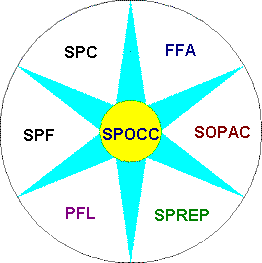
Regional organizations in the Pacific Island Sub-Region
Following World War II, and the invention of international aid, the British, Australian, New Zealand and American governments set up mechanisms for dialogue and mutually beneficial co-operation between their Pacific island colonies. These organizations were specifically organized to wholesale aid to the region and enable local co-ordination of development projects.
Today, these regional organizations have multiplied and play a critical role in shaping national government policy. There are almost 200 regional organizations, but the major ones are:
The South Pacific Commission (SPC) now renamed the Secretariat of the Pacific Community, the South Pacific Forum (SPF), the South Pacific Regional Environment Program (SPREP), the Forum Fisheries Agency (FFA), the South Pacific Applied Geoscience Commission (SOPAC) and the Pacific Forum Line (PFL).
The South Pacific Organizations Co-ordinating Committee (SPOCC), made up of the heads of the regional agencies, meets to consider how the organizations can work together and avoid duplication of effort and policy conflicts.
The South Pacific Forum Secretariat represents the Pacific islands in international meetings and creates policy for the entire region, the other organizations, including SPOCC, act as technical organizations to assist in meeting policy goals. The SPF, with the current exception of the Energy Programme, no longer has technical programs of its own (Bob Dun, personal communication 1997).
If the multitude of regional organizations could be thought of as a government of Oceania, SPF would be the executive branch, but without any legally binding authority over the other members. The entire network relies exclusively on mutual co-operation.
A number of other regional organizations concentrate on specific sectors to:
- Alert governments to problems and opportunities of common interest.
- Provide a means to exchange information on specialized topics.
- Enable governments to create a co-ordinated regional policy beneficial to all concerned.
Regional co-operation for environmental policy development in Pacific island countries.
The first regional environmental policy of Pacific island countries was prepared by the multi-governmental South Pacific Regional Environment Programme (SPREP) and adopted by its 22 member governments in 1983. The South Pacific Commission, the South Pacific Forum, ESCAP and UNEP formed SPREP in 1980 as the environmental planning co-ordinator for its member countries. Initially, the SPREP secretariat was based at the South Pacific Commission in Noumea and its work plan supervised by an oversight committee of the South Pacific Conference and the South Pacific Forum. Each country appointed a SPREP focal point to work with the Secretariat. In 1986, the countries signed a legal Convention for the Protection of the Natural Resources and Environment of the South Pacific Region (The SPREP convention).
Starting in the late 1980's SPREP, ESCAP, and other international agencies assisted its member countries in developing:
- A National State of the Environment Report
- A National Legislative Review
- A National Environmental Management Strategy
Following a period of inter-organizational feuding between the SPC and the SPF, SPREP moved to Apia, Samoa. The 1993 SPREP Treaty established SPREP as an autonomous organization.
SPREP played a key role at UNCED in 1992 and the follow up Global Conference on the Sustainable Development of Small Island Developing States held in Barbados in April of 1994. The conference was the first major meeting to implement Agenda 21 in developing countries.
SPREP responded with a revised regional strategy for the Pacific island states; the 1994-1998 Action Strategy. This Strategy reflects both the Agenda 21 framework principles and recommendations of the Small Island Developing States conference. It has a coherence that has been lacking in former framework packages, with a welcome stress on mission - and audience - oriented information and monitoring. Community participation is built into all aspects of the plan, as is a greater degree of co-operation with NGO's. The Strategy's pointed suggestions to donors are important reminders of the need for all interested parties to consider the long-term implications of their actions.
The SPREP 1994-1998 Action Strategy was intended as a policy for any individual or organization interested in helping "to protect the rich natural heritage of the South Pacific forever through the conservation and sustainable management of its natural resources and biodiversity for the benefit of the peoples of the South Pacific and the world." Effective action is more possible now than ever before as:
- Most Pacific Island countries have National Environmental Management Strategies.
- Sustainable development has broad international acceptance with a framework for islands in the Barbados Programme of Action for the Sustainable Development of Small Island States.
- Organizations, particularly NGOs are launching community-centered conservation area projects in several Pacific island countries.
- Countries are developing an interest in ecotourism.
The new plan concentrates on making sustainability an integral part of Pacific island life. Their six point strategy has specific measurable objectives, prioritized key actions, identification of how and where these actions will be implemented, and a way to regularly measure progress towards these objectives.
The focus of the strategy is on the interaction of people and natural resources. It is simple and brief, focussed on the most critically needed actions rather than being a shopping list of possible activities. To be effective, the strategy must be included in annual work programs and annual reviews of progress. SPREP has provided an excellent series of quick review forms to record progress towards the goals of each action strategy. The six objectives are:
.
- Objective 1. To develop National Environmental Management Strategies for all countries and territories within the region and begin to implement priority conservation and sustainable resource management actions in at least half the countries and territories by 1998
- Objective 2. To develop and advocate appropriate funding mechanisms for the sustained support of conservation and sustainable resource management activities at the local, national and regional levels.
- Objective 3. To identify and address the most urgent threats to the regions biodiversity and protect the region's plants, animals and ecosystems for future generations.
- Objective 4. To involve communities in co-operative natural resource management that recognizes and strengthens local resource owners' rights and uses environmental sound customs.
- Objective 5. To strengthen local expertise and technical ability in planning and implementing sustainable natural resource management programs for marine and terrestrial environments through programs of training and extension that use local expertise wherever possible.
- Objective 6. To improve environmental awareness and information sharing and to build working partnerships at the local, national, regional and international levels in support of conservation activities.
Emphasis was placed on research, resource inventories and information gathering as fundamental components of all conservation activities rather than a separate objective. Information gathering is linked with each conservation action that they support in order to focus research efforts on applied information needs.
American Samoa, Guam, the Commonwealth of the Mariana, French Polynesia, Wallis and Futuna, and New Caledonia operate as parts of the United States and France and as such, their environmental policy is the same as their central governments. In theory. In practice, the duality of spirit common to all the island countries, European versus Indigenous, splits the policy into a legal and para-legal system.
National resource use policy in the Pacific sub-region was created at the highest levels of government, usually in Cabinet or its equivalent. In addition to the key role played by aid donors and regional organizations, the decision makers were keenly attentive to potential investors and developers. Often policy became a balance of economic factors and written policy did not always reflect government action.
Political demands made by the people of the country were also important to policy decisions. The recent fall of governments in the Solomon Islands and PNG were directly linked to public dissatisfaction with governmental abuse of natural resource policy.
Lower levels of administration operate within the policy framework, planning, implementing and monitoring government actions. This then leads to the formulation of laws and regulations that govern development activities and the use of resources.
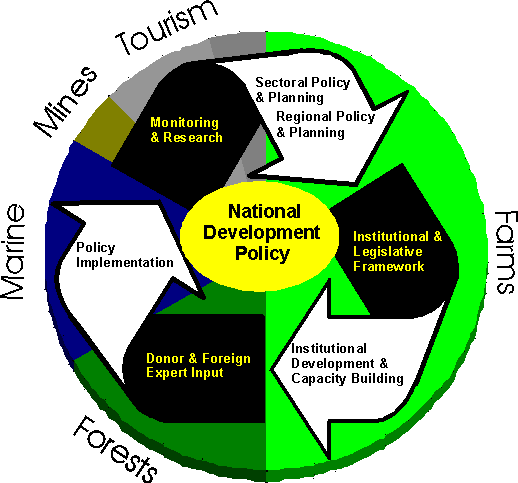 |
The traditional development cycle for natural resource policy is superimposed on local knowledge about natural resources and the choices for using them.
3) The major types of policy conflicts and their social and economic costs.
Policy conflicts within the National level
National development policies include some variation on the following:
An overall goal of improving the economic and social well being of all its citizens through:
- Bringing about economic development (private sector development).
- Distributing opportunity to participate in development to all people and areas (poverty alleviation)
- Ensuring that development is sustainable and will be accessible to future generations (concern for the environment).
Achieving any one of these three policies may conflict with strategies in the other two. For example:
- Attempting to increase the contribution of fisheries or forestry to economic development through increasing production may conflict with the exhaustible nature of the resources.
- Stimulating private sector growth may lead to environmental degradation through habitat destruction and pollution.
- Increasing support for private sector development may remove development opportunities from the poor, especially if large-scale operations are favored.
- Environmental policies for management of living resources or protecting habitats may remove fishing, logging, mining, and agricultural opportunities from poor operators and small businesses.
- Poverty alleviation policies may result in increased resource use and habitat destruction, thus creating more environmental problems.
- Improving the skills and
tools of the poor and promoting alternative income
earning activities may raise the cost of labor and thus
increase commercial operating costs and slow the private
sector growth.
Policy conflicts between different sectors of the government.
Mining, agriculture, forestry, fisheries, energy, and tourism often have conflicting strategies. The efforts to create economic growth, alleviate poverty or improve the environment in one sector may defeat the strategies to achieve the same thing in one of the other sectors. Some examples are:
- Agriculture promotes growing crops (often of low value) for export. Their plans include large scale farming with clearing of the land and copious use of fertilizers and pesticides. This results in pollution of rivers with silt, nutrients and poisons that cause long-term damage to coral reef habitats and a subsequent loss of fish catch.Forestry promotes large scale logging operations resulting in sedimentation of rivers, habitat destruction, coastal erosion, coral reef death, and permanent loss of agricultural areas through soil depravation, loss of the water-recycling function of the trees, and decreased protection from storms.
- On coastal areas, multiple demands on resources can lead to open conflict. Fishers, who depend on the coastal area for survival, have a low status and cannot influence coastal zone planning processes aimed at high profile sectors like tourism, housing, and road construction.
- Development activities from any one sector compete with development activities from all the other sectors. Individual people in a community often engage in farming, fishing, transportation, small scale forestry and tourism activities. Not to mention Church and social obligations. In the Pacific Islands, there are so many development schemes in progress that nobody has time to do any of them effectively. Workshops and conferences can be so numerous, employees in the understaffed government offices find it difficult to get day to day work done.
Policy conflicts between national and local government structures.
Development of natural resources are supposed to contribute to national development objectives, especially for income distribution and increased self-reliance. National offices tend to favor large scale development activities while local offices often promote micro-enterprises. Fishers and fisheries officers may receive conflicting sets of advise from the national versus the local authorities.
In 1979, the Papua New Guinea National Fisheries division, responding to advice and large scale funding from an international agency, promoted a Coastal Fisheries Program based on the installation of fish freezer plants to encourage the processing and export of fish from remote coastal areas to the highlands and overseas. (Opnai & Aitsi. 1995)
The Milne Bay Provincial fisheries officer felt the local fishers, and especially the youth, needed the opportunity to develop on a smaller scale, to supply the local market. The local capability, according to provincial plans, would slowly grow to be able to meet export demands.
The facility planned for Misima by the National scheme required a 2 ton per day throughput of quality fish products to break even financially. Local subsistence fishers could not supply this and the artisanal fishery was still too small and limited to supply it.
National Fisheries office solved the problem by bringing in commercial fishing vessels which stripped the reefs to supply the freezing plant, thereby reducing the self-reliance and nutrition of the local communities. The Misima plant closed after considerable economic loss.
Subsidized by international aid, the project ran for nearly 20 years with an annual budget of 2 to 3 million Kina. Finally, in 1994 the remnants of the projects were privatized.
The coastal fisheries development priority 1995? "no further promotion of capital intensive fisheries stations." "Participants in coastal fisheries should come from local communities and the resource owners to avoid conflicts of interest.." (Opnai & Aitsi. 1995)
Conflicts between resource use policy and international obligations, treaties and relations.
The countries of the Pacific regulate their international relations through regional and global agreements. These obligate the countries to work together and adopt common strategies. There are numerous agreements related to sustainable development and protection of the environment, the most important umbrella agreements on the environment being the South Pacific Regional Environment Program and Agenda 21.
While the countries in the Pacific may agree on the policies outlined in these agreements, they seldom follow them in practice. One reason for this is that the agreements are not understood by the management-level people in the government or the private sector. Fishers, Loggers, Miners or Public Works employees, for example, will seldom have any understanding of the relation between their actions and Agenda 21 or the Biodiversity Convention.
Assistance given by outside funding agencies have resulted in policy conflicts. In addition to the citation box above concerning PNG coastal plans, Vanuatu provides a valuable insight into the issue of sustainability and international assistance (see adjacent box quote).
International labor agreements can cause conflicts when, for example, migrant workers enter the workforce. Mining, forestry, tourism, and business developments created through international assistance or as bilateral trade agreements may conflict with social harmony, employment opportunities and small business development for local people.
Conflicts also arise when resources are shared by more than one country. Migratory fishes, such as Tuna, are the prime example in the Pacific. Potential conflicts in this area have been moderated by the formation of the Forum Fisheries Agency, a regional intergovernmental agency that mediates migratory fisheries in the Pacific sub-region.
Bilateral fishing conflicts are uncommon between Pacific island nations because they are widely separated. Australia, however, has had resource conflicts with Indonesia over the deepwater snapper fishery of the Timor Sea (Ramm 1995) and with PNG over the Torres Straits sea cucumber fishery (Lokani 1995).
Policy conflicts between levels of economic policy making
Economic policy, and economic policy conflict, was not limited to governments. Communities - including villages or groups of people linked by common interest in fisheries or agriculture or religion - also created economic policies. Households and individuals made economic policies and these often conflicted with the policies of other levels of society.
The whole spectrum of economic policies are inseparable parts of the whole island society. Where there was significant conflict between National government policy and village policy, the government policy was ignored.
Conflict between self-interest and altruism.
The most basic conflict of all is that protection of the environment and conservation of natural resources always is against the immediate best interests of the people who are using them. Individuals, families, and communities have economic policies, too, and make daily decisions on how they use or abuse their resources. (see Rice et al Scientific American April 1997)
This does not come out in meetings and discussions where government agencies responsible for natural resources are quick to support the concept of sustainability and environmental protection. It comes out in the day to day economic decisions of men and women at work in the gardens, gathering food from the reefs, operating bulldozers in the forests, and working in industrial sites.
- It was in the best economic interests of the manager of the power plant in Kiribati and in Nuku'alofa Tonga to simply let the used oil and floor washings wash out into a shallow pond where it seeped into the ground (and the groundwater lens).
- It was in the best economic interests for BHP's operation managers of the OK Tedi mine in Papua New Guinea to allow the run-off from their mining operations to pollute the OK Tedi and Fly Rivers (until the local community sued them for 4 billion dollars).
- It was in the best economic interests of the Malaysian logging company, Maving Brothers Ltd. to strip the trees from forests that local villagers intended to log sustainably and to take trees from proscribed areas adjacent to waterways so that the only fresh water source on southern Pavuvu was polluted with silt.
- It was in the Samoan fisher's best interests to take the lobster even though it was undersized and carrying eggs because if he didn't take it somebody else would.
Sustainable use means "restricted use," a concept that conflicts with the concept of development as a process of improving each person's access to resources.
Self sacrifice, as a policy, is often at odds with the prime development policy of improving the economic and physical well being of every citizen.
There are economic justifications for some day to day acts of self-sacrifice. Non-compliance with community laws and regulations can lead to economic fines through the justice system (providing there is actually an enforcement capability) and through social and economic acts of retribution against overt violation of community policy. But by and large, sustainability is a moral or spiritual imperative.
The Church and sustainable policy conflicts

The Church plays a central role in the lives of Pacific islanders.
More than 80% of Pacific islanders resource owners are devout Christians. This is the source of considerable (but often invisible) conflict between environmental organizations and Pacific islanders. People in governmental, international, and non-governmental environmental organizations in Australia, New Zealand, and the United States are often not Christian, and sometimes are overtly anti-Christian. This schism prevents communication on critical issues of morality that are the heart of all environmental problems. There is a total lack of the word God in almost every governmental or intergovernmental document on the environment or resource use. The word Church does not appear in Agenda 21. Spiritual appears only three times (Chapters 11,15, and 36) but not in reference to a motivation for sustainability or environmental protection.
Government agencies co-opted environment when the concept emerged from concerned natural scientists and public health and natural resource departments. They went on to formulate legislation within political and economic contexts.
The Church paid little attention to the whole affair as it was, after all, a governmental matter, linked to water and sanitation. In addition, the environmental movement was full of "naturalists" who damned the Christian ethic as a major cause of environmental abuse.
The environmental mobilization of the world's churches began in 1992 with a summit meeting between scientific and church leaders in Washington DC. Prominent scientists openly asked church leaders for help, explaining that environmental problems were basically spiritual and moral issues, not scientific problems. As a result, the religious leaders formed The Religious Partnership for the Environment, comprised of all major religions. The Partnership provides a framework for environmental action for over 500,000 member congregations of all faiths in the United States. It offers a religious and moral perspective to all those seeking to conserve the full diversity and majesty of God's creation. The Evangelical Environmental Network links people interested in upgrading the Church's position on environmental issues.
While the churches of the Pacific islands are reasonably well funded and have established networks, their direct involvement in environmental issues remains poorly developed. The Pacific Conference of Churches (PCC), with 31member churches in 22 Pacific nations, is endeavoring to bring its Member Churches into the process of environmental awareness and education.
Costs of Policy Conflicts
The combined policy conflicts caused a serious waste of time, effort and money and a general lack of progress towards sustainability. Island governments have enough problems without multiplying them with conflicting policies.
The cost of policy conflicts can be illustrated by the political and economic penalties of ignoring community policy in Bougainville, Papua New Guinea. The civil war cost hundreds of millions of dollars in military action, the closing of the country's largest copper and gold mine and destruction of the Mine's equipment. It cost the Prime Minister his job when he hired a team of professional mercenaries to attack the people.
The people of Bougainville complained for more than 20 years about the pollution in their rivers and even more strongly about the pollution of their social systems. The mining company paid land use fees to the islanders, so the local people were not very interested in working in the mine. In addition, there were too few of them. So the company hired young men from the highlands. Since these often left after a few months, the company shipped in almost double the number of workers it hired at any one time. The company had its own ship which arrived with beer and prospective workers on a regular schedule (a large proportion of wages paid were used to buy the beer from the company). The excess labor force of energetic young men had no access to money, land, gardens, or women. They did have access to beer and knives and an economic and social policy that resembled the gangs of unemployed youth in Port Moresby.
Ignoring the economic and social policies of the resource owners and users is a chronic problem in all Pacific island countries. It is becoming an acute problem, as local policies are stressed by population growth and economic desire.
Chronic conflict is a characteristic of small Pacific Island country societies and, over the millennia, people have developed a number of traditional ways of minimizing adverse effects. These traditions are essential to community harmony, but play havoc with western government and economic systems. Since conflict is mediated by information flow, it is here that Pacific islanders exert their social controls. Vertical and horizontal flow of information is rigidly controlled with a complex array of mechanisms; in Polynesia and Micronesia, the mechanisms are social rules of conduct. In Melanesia the mechanism was the evolution of the one-talk system which resulted in more than 1100 languages in the island archipelago extending between PNG and Vanuatu.
The unifying effect of English has complicated the control system in Melanesia. In Polynesia and Micronesia English is separated from local languages by an ideological and social information chasm with few bridges that span the two sides. On one side of this chasm we find the Western World, along with its economic and political laws. On the other side is the traditional Polynesian or Micronesian world with its own economic and political laws.
Any proposed system to harmonize policies must do so peacefully and with respect for all parties on all levels of society or it will not be acceptable to Pacific Islanders.
4)The process of policy harmonization
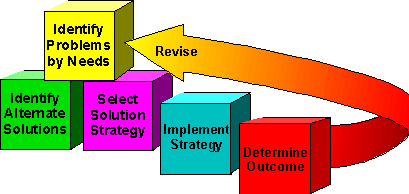 |
Policy harmonization is a 6 step planning cycle of:
- Gathering information to identify the needs of all the people and organizations of the country and the needs of the plants, animals, and essential resources.
- Exploring possible ways to meet needs that are not currently being satisfied.
- Selecting the best way to proceed and making this the current policy.
- Implementing the policy with an action plan.
- Monitoring the effect of the action plan.
- Revising the plan and the policy as needed.
Harmonizing the many conflicts that exist in the policy process is essential to successful environmental planning for sustainable development. The process of harmonizing conflicts begins with research. The process of conducting the research is probably the most important and useful part of the whole exercise so long as the people who are involved in the issue define the research agenda and then do the research themselves.
Identification of the needs of each group is the most critical step. Government, commerce, the public, international interests (including tourists, intergovernmental agencies, international banks and companies) and the natural environment all have specific, often conflicting needs. This is where the participatory element is needed most. In the past, the needs were assessed by the government, often (usually) without ever discussing the issues with the people, their organizations, and the smaller business concerns. The Agenda 21 process suggests having representatives of the different groups develop a vision of what they would like their future world to be like; a definite vision with actual targets that can be measured and indicators to see if their future world is developing according to their needs.
Needs not met are problems. These must be clearly identified and prioritized with the people concerned. Government priorities, often set by international funding opportunities, may have no relation to the priorities of the majority of the people of the country or to the natural life systems that supports everyone and all their activities.
Next the priority problems are examined and compared between the different groups. Commonalties and differences become evident and the group must put the pieces together as a coherent picture of the combined problems.
Then, working together, alternative solutions are identified, strategies developed from the best solutions, and these are implemented.
Every three to six months, key indicators of progress are examined to determine the outcome and the plan is revised as needed to meet the planning targets.
This process is, itself, a vision as it is so rarely done in the Pacific islands.
Participatory Integrated Policy (PIP)
Typical Resource Assessment and Policy making cycle in the Pacific islands.
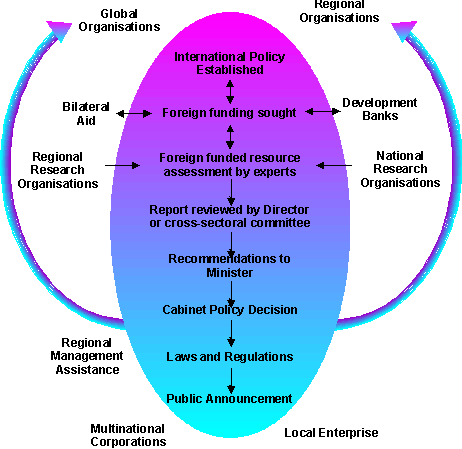 |
The above figure shows the existing resource assessment and policy making cycle in the Pacific islands. It is driven by funding from global and regional organizations, bilateral aid and development banks. Rural Pacific islanders (who are the owners and users of the resources) are rarely represented in the planning cycle.
Instructions to the public drop out of the cycle as public announcements. Local enterprises, multinational companies and regional advisors play a side-line role in the policy process, exerting influence at various informal opportunities. National and Regional research organizations feed advice into the process.
The next figure shows a generalized sketch of the full participatory integrated policy process that might one day exist after the initial training of government officers and the villagers themselves is more advanced. In future, representatives from the village will attend provincial meetings with sectoral or cross-sectoral government committees to represent village level policy and plans at the provincial level. The resultant policy and planning is then compared to existing policies and plans are adjusted accordingly.
Participatory Resource Assessment Cycle |
The PIP process provides a structured framework to research, dialogue, decision making, institutional reform and resource allocation. It represents a partnership between government and all stakeholders in a sector or sub-sector to achieve sustainable use of the resource base. It has been described as a empowering, decentralized, integrating, ongoing, long-term, multi-disciplinary process. It also requires a reallocation of rights and duties between the different levels of government and society and depends on the formal recognition of these rights and duties by all concerned.

